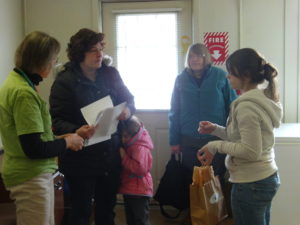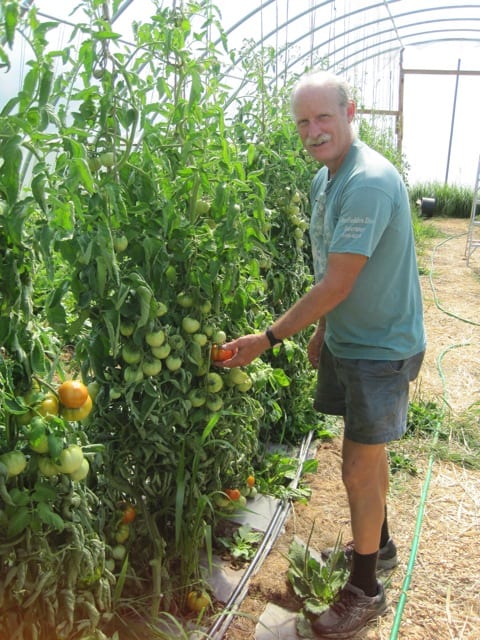Using Software to Help Build and Support Local Food Markets
by Kim Mills, Sue Rau, Jason Evans, and Jim Ochterski
In this article, we draw on our experiences with two local food markets operating with Local Food Market Software to describe how software can be used to help build and support a local food market.

Schoharie Fresh market day. Producers from Elderberry Herb Farm (back left), and Sap Bush Hollow (back right), dropping off their products to Schoharie Fresh intern Liz Goblet (front right), and Project Coordinator Maureen Blanchard (front left).
Schoharie Fresh is an online consumer retail market in Schoharie County, New York. This project was established with the support of a New York State Healthy Food/Healthy Communities grant. Schoharie Fresh was launched in August, 2010 using the Local Food Market software.
The North Country Grown Cooperative is a local wholesale market in St. Lawrence and Franklin counties, has been in operation for many years, and began using this software in August, 2011. Adapting the software to the North Country Grown Market was supported by grants from the Cornell Small Farms Program and the USDA. The Local Food Market software we describe was also developed with support from the New York Farm Viability Institute.
In both markets, Local Food Market software is used to reduce transaction costs, and make the market more profitable through increased convenience, reduced uncertainty, and building a local market database. Local Food Market software is a management tool to complement the operation of a local food market.
Using Software in Local Food Markets
All markets have costs associated with bringing buyers and sellers together to complete a transaction, and in a local food market these include:
- A grower investing in production with uncertain future sales,
- A buyer finding local products at specific times, prices, and quantities, and
- A market manager identifying producers, products, and prices, and managing invoices, delivery, purchase orders, and inventory.
In Schoharie Fresh and The North Country Grown Market, we used software to improve the flow of information, and provide better coordination of market activities. While all transaction costs outlined above are not impacted by this software, many transaction costs are reduced. The benefit to both markets has been increased convenience, reduced uncertainty, and a database of information on the market. For each topic below, we describe examples of how Local Food Market software helps support profitability.
Increased Convenience
Ways that customized, online software increases convenience for buyers, sellers, and managers in a local food market include the following examples:

North Country Grown Market member farmer John Dewar of Village Veggies in Potsdam, NY.
- Schoharie Fresh farmers know in advance order pickup dates and how much inventory is actually sold—they know which products and exact amounts to harvest and deliver for sale. Farmers and their staff are not tied to a physical market location for an entire day.
- Schoharie Fresh customers benefit from a larger number of farmers to buy from, increased product variety, and clear prices. This is due to an “open door policy” for local farmers, which is easily accommodated in an online market.
- Customers have the convenience of shopping from home, as well as the opportunity for some in-person interaction with local farmers and access to product samples at the pick-up site.
- On a twice weekly cycle, the manager of North Country Grown Market assigns pending sales to member farmers from a software-generated sales report. Compared to the previous paper based system, this step is a great time saver. Generating purchase orders from the software is more easily carried out, allowing the cooperative to pay farmers in a timely manner even during the busiest periods of the season.
Reduced Uncertainty
Ways that customized, online software reduces uncertainty for buyers and sellers in a local food market include the following examples:
- North Country Grown Co-op member buyers prefer to buy from local member farmers, but face uncertainty in product availability. The Co-op has asked buyers for purchase projections for several years, and in the previous paper based system, recorded a single, annual quantity for a product that farmers used in crop planning.
- North Country Grown Market software is now used to collect buyer purchase projections and farmer forecasts for the coming season in two week intervals. Detailed software reports, comparing purchase and forecast quantities over two week intervals support both pre-growing season and in-season adjustments. This tool helps the cooperative to optimize sales of local products. Aggregate projections and forecasts are used for planning the next season’s purchases and sales.
- In both Schoharie Fresh and North Country Grown Market, an online inventory feature tracks products as buyers submit their orders. Double selling or ordering an item that has already been sold is eliminated, and buyers can be nearly certain they will receive everything they have ordered. Farmers can download their purchase orders for delivery day, and know exactly the products, quantities, prices, and total sales for the day. Farmers also have access to historical sales records.
Database of Information on the Market
Ways that customized, online software builds a database of information on the market to better support market operations include the following examples:
- In Schoharie Fresh, record keeping of all accounting functions is supported by the system database. Managers can print invoices, orders, and summary reports. Specific product orders can be generated as needed, such as to settle a disputed order.
- In the past, the North Country Grown manager had to manually generate an invoice for each buyer during each delivery period. A corresponding set of purchase orders had to be generated for each farmer. Invoices and purchase orders had to match inventory, with each item entered by the manager once on the invoice and once on the purchase order. Only the manager could ensure all necessary details were correctly recorded. Now a database of sales transactions is used to generate buyer invoices and purchase orders for farmers. Financial data is exported from the system to provide the necessary detail to a bookkeeper to manage the financial records of the cooperative.
- North Country Grown farmers typically kept planting records on paper, but not always in a well-organized format. Farmers can now log into their North Country Grown account and enter planting data for each crop, and several succession plantings of the same crop. Seed variety, expected and actual planting and harvesting dates, and expected and actual crop yields are recorded. Planting databases for each member farm provide a detailed and easily retrieved record to plan from in the next growing season.

The software allows the manager to assign pending orders to member farmers with a mouse-click. Producers offering a product can be assigned to an order, the assignment can be cancelled and re-assigned, and the pending order can be reduced in quantity or divided into multiple orders.
Summary
We used our experiences with two local food markets in New York State to describe opportunities for creating more profitable markets. We focused on “back-office” operations where we used software to better manage the flow of information between buyers, sellers, and market managers and to better coordinate many of the activities required to operate a local food market.
We identified three benefits of using Local Food Market software: increased convenience, reduced uncertainty, and building and using a database of market information. This approach may help expand small farm access to local and regional markets, and make local food more easily available to wholesale and consumer markets.
For more information on the Local Food Market software described here or partnering on a local food market project, please contact Kim Mills at millsk@morrisville.edu, 315-256-5182.
Kim Mills teaches in the Computer & Information Technologies department at Morrisville State College in NY, and develops software for local food markets. He can be reached at millsk@morrisville.edu.
Sue Rau is a farmer and the manager of North Country Grown Cooperative in Canton, NY. She can be reached at manager@northcountrygrown.com.
Jason Evans teaches in the Agricultural Business department at SUNY Cobleskill, and manages Schoharie Fresh.Com. He can be reached at evansjr@cobleskill.edu.
Jim Ochterski is Agriculture and Natural Resources Issues Leader with Cornell Cooperative Extension in Ontario County, and is leading an effort to work with local famers, chefs, and consumers to establish new markets for local food. He can be reached at jao14@cornell.edu.


This article highlights the challenges faced by local food markets, such as growers’ uncertainty about future sales, buyers struggling to find specific local products, and market managers dealing with various tasks like managing invoices and inventory. Utilizing offshore software development services https://ein-des-ein.com/services/offshore-software-development-services/ could offer a practical solution. These services can help streamline market operations, improving communication between growers, buyers, and managers, making it easier for everyone to connect, trade, and ultimately support local food markets more efficiently.